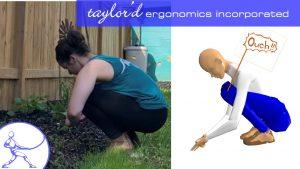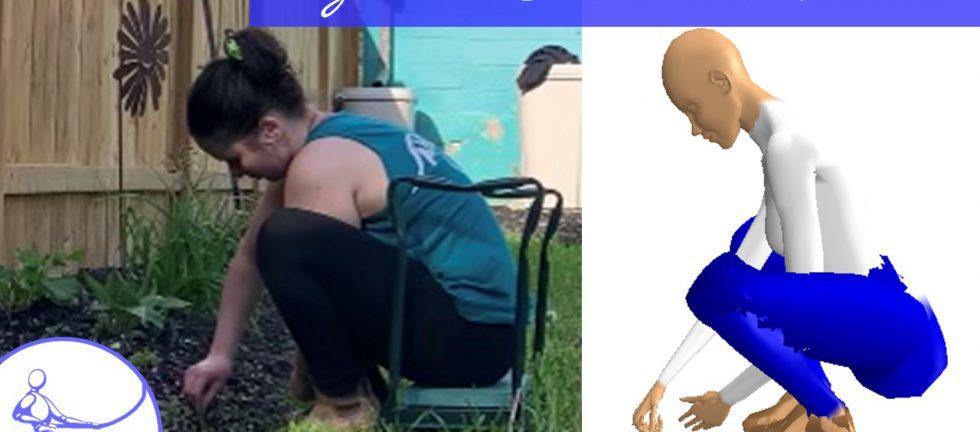
Most ergonomists love to play with “ergo” toys, and Josie is a gardener, so she volunteered to trial this gardening tool, found here on amazon.ca. The “garden kneeler” is a folding device with a cushioned top, designed to make gardening more comfortable.
Josie typically sits, kneels, or squats along the edge of the garden bed, reaching forward to plant or weed. The lunchtime conversation that prompted this trial centered around the potential for bee stings in awkward locations. (Ouch!) A stool should reduce this risk; if bees are about, they would be easier to detect on the stool than in the grass. But does the stool offer an “ergonomic” benefit? As we discuss in our workshops, there is no legislation around the use of this promise – a manufacturer does not have to prove that a product offers an ergonomic benefit. (Although if it does, they certainly can…contact us for help!)
I ran the biomechanical analyses for this review assuming that Josie pulls weeds using an average of 10 kg of force. When Josie leaned on something, I applied leaning forces. The kneeler has three possible uses: you can kneel on it or sit on it in its low position, or flip it around and sit on it like a stool, for a raised garden bed. Josie doesn’t have raised beds, so we looked only at the low position options. Here’s what we found – as is often the case, it was complicated.
When I compared squatting with sitting on the kneeler, I found that the demands on the muscles around the knee joint were four times higher when squatting. (Of course, some folks with knee injuries wouldn’t be comfortable in either position.) The demands for the rest of the joints are about the same either way.



When I compared kneeling on the grass with kneeling on the kneeler, I noticed that Josie used different techniques. On the grass, she tended to support her body with one hand on the ground while pulling with the other hand. This created high loads on the back and shoulder. When she knelt on the kneeler, she rested one elbow on her thigh while pulling with the other hand. (We call this “diverting the load”.) Using this method reduced the back demands by 50%, although the arm demands increased a little, due to the longer forward reach.

Why did Josie “divert the load” when she was using the kneeler, but not when she knelt on the grass? As you bend and reach forward to transition from kneeling to the 3-point support position, your weight shifts from your feet, shins, and knees, to your knees only. The kneeler might wobble or fall over if you tried this while balancing on it. If you can’t safely get into the 3-point support position, you have to reach further forward to pull the weeds. Diverting the load by resting the elbow on the thigh takes some strain off the back. Josie might have selected this technique without even thinking about it.
What did Josie think of the kneeler? She said, “It’s a good tool to introduce some variety, and great if you need to sit in one location for a while. But I find that pulling weeds requires a lot of moving, so dragging the stool along each time adds up. Plus I like sitting in the grass, despite the risk of bee stings!”
For a client, we would write up a concise report with all of the numbers, and we might make suggestions to improve the design or the proposed method of use. For this article, I simply wanted to highlight the process. If you’re trying to compare two tools, or two different ways of doing something, we can help! Our biomechanical analysis tools can provide objective data – measurements that can inform your decisions.


